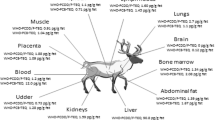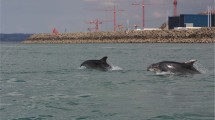Abstract
A range of organohalogen compounds (10 polychlorinated biphenyl [PCB] congeners, DDT and metabolites, chlordane-related compounds, the potential natural organochlorine compound Q1, toxaphene, hexachlorobenzene, hexachlorocyclohexanes, dieldrin, and several yet unidentified brominated compounds) were detected in the blubber of four bottlenose dolphins (Tursiops truncatus), one common dolphin (Delphinus delphis), and seven dugongs (Dugong dugon), as well as in adipose tissue of a green turtle (Chelonia mydas) and a python (Morelia spilota) from northeast Queensland (Australia). The green turtle and dugongs accumulated lower organohalogen levels than the dolphins. Lower levels in dugongs were expected because this species is exclusively herbivorous. Highest PCB and DDT levels recorded in dugongs were 209 and 173 μg/kg lipids, respectively. Levels of the nonanthropogenic heptachlorinated compound Q1 (highest level in dugongs was 160 μg/kg lipids) were estimated using the ECD response factor of trans-nonachlor.
Highest organohalogen levels were found in blubber of dolphins for sumDDT (575–52,500 μg/kg) and PCBs (600–25,500 μg/kg lipids). Furthermore, Q1 was a major organohalogen detected in all samples analyzed, ranging from 450–9,100 μg/kg lipids. The highest concentration of Q1 determined in this study represents the highest concentration reported to date in an environmental sample. Levels of chlordane-related compounds were also high (280–7,700 μg/kg, mainly derived from trans-nonachlor), but concentrations of hexachlorobenzene, hexachlorocyclohexanes, dieldrin, and toxaphene were relatively low and contributed little to the overall organohalogen contamination. Furthermore, a series of three major (BC-1, BC-2, and BC-3) and six minor (BC-4 through BC-9) unknown brominated compounds were observable by extracting m/z 79 and m/z 81 from the GC/ECNI-MS full scan run. Structural proposals were made for the two major recalcitrant compounds (referred to as BC-1 and BC-2). BC-2 appears to be a tetrabromo-methoxy-diphenylether (512 u) and BC-1 has 14 u (corresponding with an additional CH2 group) more relative to BC-1. In general, the organohalogen pattern observed in blubber of dolphins was different compared to similar samples from other locations in the world, which is apparent from the fact that the four major abundant signals in the GC/ECD chromatogram of D. delphis originated from the four unknown compounds Q1, BC-1, BC-2, and BC-3.
Similar content being viewed by others
Author information
Authors and Affiliations
Additional information
Received: 15 November 2000/Accepted: 22 February 2001
Rights and permissions
About this article
Cite this article
Vetter, W., Scholz, E., Gaus, C. et al. Anthropogenic and Natural Organohalogen Compounds in Blubber of Dolphins and Dugongs (Dugong dugon) from Northeastern Australia. Arch. Environ. Contam. Toxicol. 41, 221–231 (2001). https://doi.org/10.1007/s002440010241
Issue Date:
DOI: https://doi.org/10.1007/s002440010241




